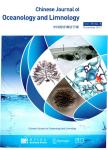Population dynamics of marine ciliate Euplotes vannus (Protozoa, Ciliophora) in different artificial seawaters
Population dynamics of marine ciliate Euplotes vannus (Protozoa, Ciliophora) in different artificial seawaters作者机构:Laboratory of ProtozoologyInstitute of Evolution and Marine BiodiversityOcean University of China Department of Biological SciencesInha University Zoology DepartmentKing Saud University
出 版 物:《Chinese Journal of Oceanology and Limnology》 (中国海洋湖沼学报(英文版))
年 卷 期:2011年第29卷第1期
页 面:109-117页
核心收录:
学科分类:0710[理学-生物学] 0908[农学-水产] 07[理学] 0707[理学-海洋科学] 0815[工学-水利工程] 0713[理学-生态学]
基 金:Supported by the National Natural Science foundation of China (Nos.41076089,40976075) a Post-Doctoral Fellowship by Inha University awarded to XU Henglong a Grant from the Center of Excellence in Biodiversity Research,King Saud University the 111 Project of China (No.B08049)
主 题:海洋纤毛虫 种群动态 人工海水 原生动物 纤毛门 分子生物学实验 人口增长 最大密度
摘 要:To study population dynamics of marine ciliates in different artificial seawaters (ASW), the population growth dynamics of a common marine ciliate Euplotes vannus were investigated using beef extract media and rice media for five types of ASW and natural seawater (NSW). The results show that: (1) the population growth rate was in the order of NSWFlack ASWNakamula ASWSchmadz ASWOshima ASWSubow ASW and was considerably higher in rice media than in beef extract media (apart from Subow ASW); (2) the maximum density of E. vannus in stationary phase in each treatment was ranked as Flack ASWNakamula ASWSchmadz ASWNSWOshima ASWSubow ASW, and was again higher in rice media than in beef extract media (except for Subow ASW); (3) the exponential and stationary phases were longer in rice media than in beef extract media; (4) strains of E. vannus that had been domesticated for 1 year in ASW grew significantly slower, with lower maximum density and longer stationary phase than those isolated and maintained in NSW. It was demonstrated that: (1) E. vannus may grow well in Flack, Nakamula and Schmads ASW compared with NSW (mainly in terms of growth rate); and (2) Oshima ASW is the preferred choice for stock cultures of E. vannus, but the ASWs Flack, Nakamula and Schmadz are preferred for mass culture. These findings suggest that these three ASWs are effective for the cultivation of marine protozoa for experimental studies on ecology, toxicology and molecular biology.



